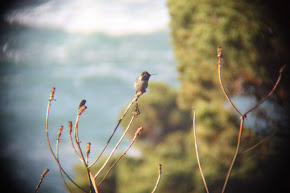We were able to get away to the coast last weekend, near Mendocino, to a town called Little River. We stayed in adjacent units to Charlotte's parents, who had invited us on the trip. It was a super relaxing break from the repetition of the Pandemic lifestyle. We hardly had to interact with other people at all, as it is the middle of winter (albeit a gorgeously sunny one) and not the most active season there.
We spent many hours on the deck overlooking the ocean, which was excitingly turbulent and powerful.
We stayed at an inn called the Heritage House, which was very nicely landscaped in that half-cultivated/half-wild way, utilizing many native species, as well as Grevillea, Echium, and other coast-tolerant, drought-tolerant shrubs from abroad.
Looking south down the coast:
And out over the crashing waves, which gently rattled the rooms when they beat on the rocky sea caves along the cliff below us.

There was a gazebo perched very photogenically on a little point that jutted out into the sea.

Looking inland from the gazebo (which was under renovation--I TRIED not to be too devestated by this). The inn has multiple units spread along the cliffside. We occupied the two rooms on the lower level of this building:
This hummingbird was often seen sitting on these dried stalks of past Matilija poppy flowers, keeping watch over his territory, including its most coveted nectar of grevillea.
Bella also was able to enjoy the Good life with us, chomping on wood burls and lounging in the ocean air.

On our first morning we were excited to finally visit the Pygmy Forest at nearby Van Damme State Park. We had been wanting to stop there on previous Mendocino trips, but hadn't, so it was nice to finally see what the heck a pygmy forest looks like.
The Pygmy Forest is actually sort of like a terrace, with 3 or more tiers of very flat land climbing up from the coastline. The nature of these geological plateaus, which varied from 200,000 to 300,000 to 500,000 years old, is such that they do not receive soil deposits from rain water runoff. Instead, rainfall tends to sit in a bog-like fashion, leeching most of the nutrients from the soil, as well as acidifying it, and also creating an iron hardpan layer, further entrapping the moisture.
As a result of these effects, the plantlife is stunted and plants like the pines, manzanitas, and rhododendrons that inhabit the area are smaller in stature than we are used to seeing them. I guess it was kind of hard to capture what makes the forest feel so peculiar when you walk through it along the little boardwalk that protects the soil from erosion. It is simultaneously boggy and dry in appearance, with a lot of light penetrating its miniature canopy.
Even the forest floor was full of petite curiosities, like the fun fluff of lichen that looked to be frothing amongst the Salal branches.
Charlotte and I of course had to stop frequently to admire the lovely Manzanita and Madrone along the trail. And equally predictably, we engaged in an agreement with the most handsome specimens to collect their seed and sow it back at home.
Some brightly colored winter foliage:
As we continued our hike out of the pygmy land and into some more conventional coniferous territory, we began to see some interesting mushrooms, like this little leaf-dweller. . .
And some species, like this Suillus, that were familiar to me from my hikes up in Oregon's coniferous forests. . .
. . . As well as what look to me like another of the Pacific Northwest's ubiquitous fungi, some type of Russula. . .
And this fine coral mushroom which we almost missed noticing while taking pictures of the pair of toadstools posed behind it.
The trail had transitioned into more of a redwood-dominated hillside, where we sat to eat in a beam of afternoon light. Selene had sent us with a delicious and hearty quinoa salad for lunch.
We left the forest and returned to the open sunshine, stopping on the drive back to take in the view from an overlook:
Back at the inn, the descending sun illuminated the ocean's salty spray and we prepared for a sunset show.
Bella, also disappointed about the out-of-commision gazebo, but trying not to show it:
These pretty iceplant flowers had a unique color to them. . . Perhaps stained permanently the palette of Pacific Ocean sundown?
Cypress, I believe:
I was excited to see these dudleyas clinging to the edge of the cliff, having just purchased a very similar-looking plant from the nursery labeled "North Coast Dudleya", purportedly a variety endemic to one cove along California's coast. Unfortunately, I have heard that there is a global demand for this family of succulent (I believe as houseplants?) and they are often poached from the wild.
Well, it was a delightful excursion. I am thankful to have been able to get out of town and out to some of the most beautiful scenery that I know of, and to take in the sights, sounds, and fresh air with my sweetheart, as well as Hal, Selene, and Bella-boo.
Cheers!































It looks like you had some of those extra glorious conditions that can happen in fall or winter. I loved the seascapes and the tiny mushroom rising from the leaf. Tuesday, December 8, had some of the biggest swells in years (50 foot + at Mavericks at Half Moon Bay) and you lucked out! Glad you had such a relaxing escape!
ReplyDelete